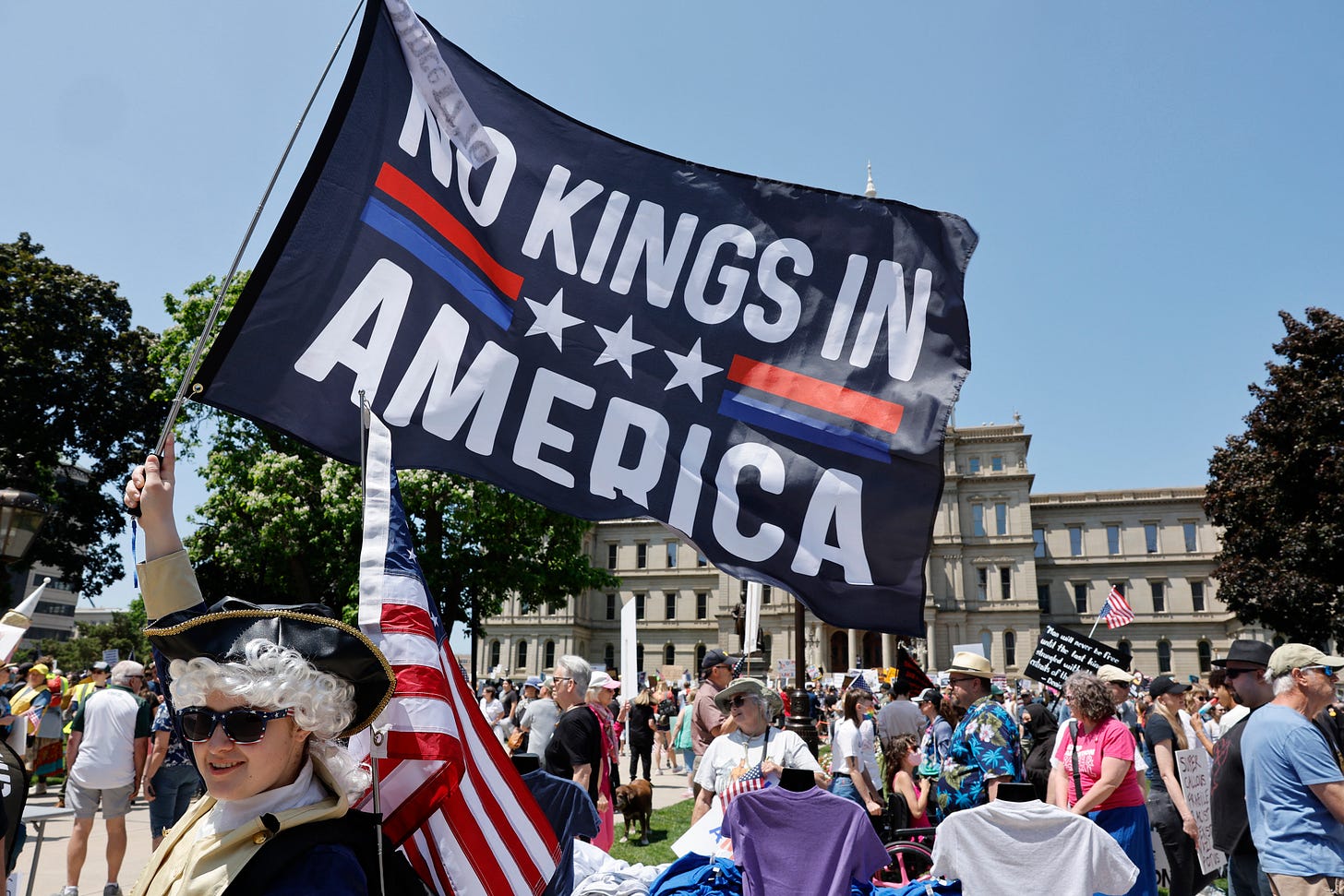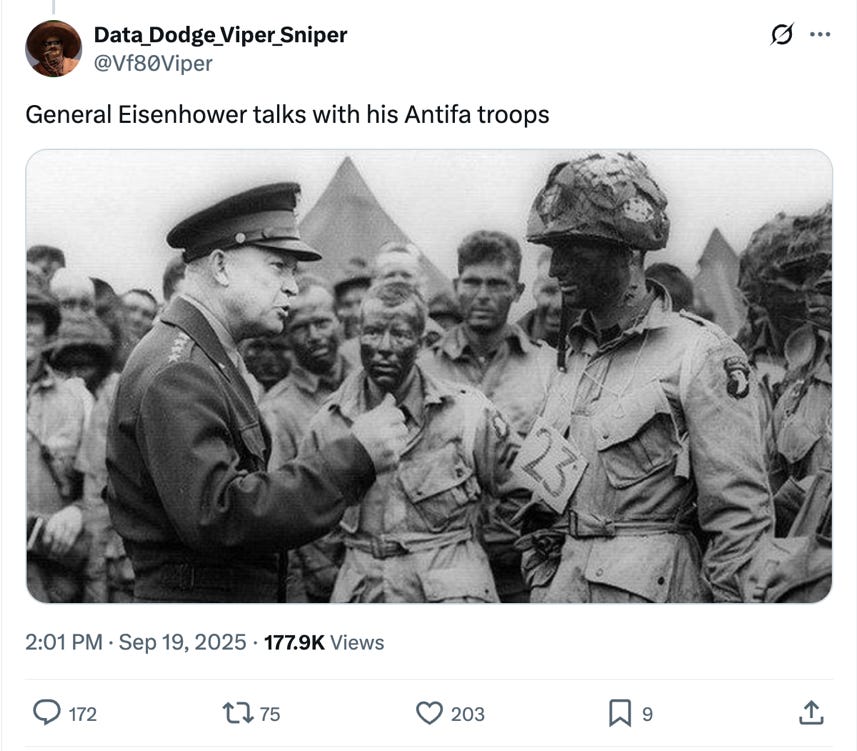9 Stupid Things People Are Saying About AntifaA terrorist organization? A fiction? All Democrats? None of the above.
Cathy Young
Oct 15, 2025

Antifa everywhere you look! Probably every one of these people. (Photo by Jeff Kowalsky/AFP via Getty Images)
ANTIFA IS IN THE NEWS AGAIN, designated a “domestic terrorist organization” by President Donald Trump and touted by his party as an all-purpose bogeyman. The Trump administration’s strategy—aided by congressional Republicans and a stable of right-wing propagandists—is a bald-faced ploy to weaponize the “Antifa” label against its political opponents, specifically those organizing and attending the “ No Kings” rally on October 18.
The pushback against this noxious narrative has been hampered by some nonsensical claims from critics of the administration.
Let’s look at some myths and facts about Antifa now making the rounds.
1. Antifa is a domestic terrorist organization.
To start with: Antifa simply isn’t an “organization” in any traditional sense of the word. (Trump labeling it a “domestic terrorist organization” is a bit like the Russian Supreme Court designating the “International LGBT Movement” as an “extremist organization.”) What does exist is a loose network of activists and groups that use the label “Antifa.” But these groups do not have a centralized or unified structure, and there’s no evidence of coordination among them. The Armed Conflict Location & Event Data group ( ACLED), which monitors conflict and crisis situations, notes that “Antifa-affiliated activists are also rarely armed and do not exhibit a pattern of recruitment, training, and integration into a chain-of-command, like most militia and armed groups.” A lot of those activists are kids LARPing as revolutionaries— mostly anarchists, anarcho-communists, left-libertarians, and radical socialists. Some may call themselves “antifascist” without being affiliated with any group.
As for “terrorist,” Antifa activists and groups have certainly engaged in politically motivated violence, harassment, and vandalism—nearly always low-grade but still reprehensible (and dangerous not only in themselves but in encouraging mainstream political violence). However, on the very rare occasions when people involved with Antifa have committed acts that may legitimately qualify as terrorism—e.g., 69-year-old Willem van Spronsen’s attempt to firebomb an immigration detention facility in 2019, which resulted in van Spronsen himself being fatally shot—these perpetrators acted as lone individuals with no collective backing.
Share
2. There is no Antifa.
“There’s no Antifa. This is an entirely imaginary organization. . . . This is no different than if they announced they rounded up a dozen Decepticons,” jeered Jimmy Kimmel the other day, in response to a statement by Secretary of Homeland Security Kristi Noem that “one of the individuals we arrested recently in Portland was the girlfriend of one of the founders of Antifa.” But, in fact, Portland’s Rose City Antifa is very definitely real. It was founded in 2007 and claims to be active throughout the Pacific Northwest. Peter Beinart reported on the group in a 2017 article in the Atlantic titled “The Rise of the Violent Left.” (Beinart, himself a left-wing progressive, expressed alarm at the group’s willingness to use violence to target what it regarded as bad speech and “to decide which Americans may publicly assemble and which may not.”) Other Antifa groups have been identified in New York, Philadelphia, and Atlanta. Claiming that Antifa is a figment of right-wing imagination looks pretty silly when people can easily point to websites and social media accounts using the label—or to photos and videos of people marching with Antifa banners.
3. Churchill and Ike were early Antifa or proto-Antifa.
According to this notion, “Antifa” means simply antifascism—which means that Winston Churchill, Dwight D. Eisenhower, and the American soldiers who fought in World War II were also Antifa or “ militantly antifascist.”
This one is a favorite trope on the left, partly because it easily lends itself to seemingly cool memes.

Actually, it’s super-cringe, if only because it is very bad history. While Eisenhower and other American leaders sometimes spoke of fighting “fascism” during World War II, it’s extremely doubtful that any of them would have used the terms “antifascism” or “antifascist.” In historical context, this language was associated with Communist politics. The German group Antifaschistische Aktion, formed in 1932—which pioneered the term “Antifa” and the logo on which modern Antifa imagery is still based—was basically the militant arm of the country’s Communist party, a Soviet-aligned Stalinist outfit.
In other words: Please don’t do this, folks.
4. Being antifascist (i.e., Antifa) is good, while being anti-Antifa means you’re pro-fascist.
There’s a term for this fallacy: “honor by association,” whereby something that has a noble-sounding name must actually be noble. By this standard, anyone who opposes the pro-life movement must hate life, and the Anti-Defamation League must hate Christians (as Elon Musk charged in a recent freakout) because it classifies “ Christian Identity”—an antisemitic race-war pseudo-theology—as an extremist ideology.
For what it’s worth, Antifa in 1930s Germany were emphatically not the good guys; they arguably facilitated the Nazis’ rise to power, not only by helping create a culture of political violence but by directing a lot of their energy toward undermining anti-Nazi moderates and centrists, whom they regarded as fascist-lite. Modern-day American Antifa, which has little similarity to its vastly larger and well-organized German forebear (it’s a bit like comparing your neighborhood basketball league to the NBA), nevertheless does share a somewhat similar outlook. In his 2017 Atlantic piece, Beinart pointed out that Antifa’s violent disruptions of pro-Trump events in Portland not only amounted to attacks on the right of peaceful assembly, but also helped fuel local far-right militancy. Also that year, reviewing Antifa: The Antifascist Handbook by Rutgers University historian Mark Bray for the Washington Post, Carlos Lozada noted Antifa’s hostility to freedom of speech for anyone its activists label a fascist or white supremacist—and its intolerance toward “conservatives or even moderate liberals who oppose fascism.”
Support our work and be part of our growing pro-democracy community—sign up for Bulwark+ today:
Join
5. Antifa was a driving force in the violent protests and riots in the summer of 2020.
It’s true that Antifa-linked groups and activists were involved in the violence in Portland and, to some extent, Seattle (particularly in the so-called “Capitol Hill Autonomous Zone”) in 2020. But nationally, their role appears to have been negligible—and the first Trump administration was already trying to inflate it. In a particularly absurd example, after an elderly demonstrator who approached a police line in Buffalo, New York was shoved by a cop and fell backwards, injuring his head, Trump tweeted that the man, 75-year-old Martin Gugino, could be an “ANTIFA provocateur”—a totally evidence-free claim based on a segment on the ultra-MAGA One America News Network.
6. Antifa is currently unleashing a wave of riotous violence against Immigration and Customs Enforcement.
In fact, the anti-ICE protests have involved no serious violence. (Joshua Jahn, who opened fire on the ICE facility in Dallas last month, was a lone gunman with no ties to Antifa or any other group and no connection to the protesters.) There is also no evidence of significant Antifa involvement in these protests. Julio Rojas of the Blaze, who participated in Trump’s “roundtable” on Antifa last week after “embedding” with ICE alongside other right-wing influencers in Portland, has shared clips from his time in the city that show the following:
- a protester throwing a tear-gas canister back toward federal agents after the agents release tear gas to disperse a crowd blocking the entrance to the facility;
- a protester getting arrested after he “dumped red paint on the federal building property”; and
- two men arguing with an agitated fellow protester draped in a Mexican flag and an American flag, apparently over the question of whether protesters should stay out of the roadway.
Rojas identifies these four individuals as “Antifa,” apparently based solely on the fact that they are wearing black or dark-gray clothes, and the ones in the first and third clips are also wearing motorcycle helmets. (Antifa activists have sometimes used the “ black bloc” tactic of wearing black clothing and ski masks or motorcycle helmets to avoid identification, and also perhaps for intimidation purposes; it is not, however, exclusive to Antifa.)
Join
7. Antifa resorts to violence only when necessary and for the just cause of thwarting white supremacist organizing, a far greater threat that leads to far more extreme and deadly forms of violence.
Mark Bray made this argument on NPR in 2020, citing such dangers as shootings by white supremacists in black churches and synagogues. But there is actually zero evidence that Antifa has helped curb far-right violence or extremism.
There is also no question that on a number of occasions, Antifa activists have used violent tactics to attack basic freedom of expression. In March 2017, they escalated a student protest at Middlebury College against an appearance by Charles Murray (best known as the author of The Bell Curve, the 1994 book that argued racial differences in intelligence are at least partly innate) into a raucous mob outside the venue; Allison Stanger, the professor who had interviewed Murray during the event, was pushed around, had her hair pulled, and suffered a concussion while trying to leave the venue with him. You don’t have to like Murray to see that this is outrageous and unacceptable.
Moreover, people who decide that they’re entitled to initiate violence in a righteous cause rarely stop at targeting the “baddies.” In 2018, during a counterprotest against a rally by the far-right Patriot Prayer in Portland, “masked antifascists” beat up a fellow counterprotester, a Bernie Sanders supporter, for carrying what they called a “fascist symbol”—the American flag. The same year in Philadelphia, two out-of-uniform U.S. Marines visiting the city for a Marine ball were punched, kicked, and maced by a trio of Antifa activists who mistook them for participants in a nearby right-wing rally. (In an ironic twist, the “antifascists” used ethnic slurs against the Marines, who are Hispanic.)
Terrorists? No. Good guys? I don’t think so.
8. Antifa is connected to the Democratic party and financed by Democratic funders.
That makes sense if, like many MAGA types, you are convinced that Democrats and Communists are the same. In reality, as mentioned above, Antifa types have a blend of backgrounds but generally oppose liberals and hate mainstream Democrats only slightly less than they hate Republicans. Exhibit A: Ironically, a photo the Blaze’s Rojas posted to prove to a Democratic congressman that Antifa is a real organization—so real, in fact, that soon after Rojas got his picture, the group (according to his own post) “attacked the Democrat office in the city.” And notice that the Antifa banner in Rojas’s picture is an anti-Biden banner. But sure, JD Vance and Stephen Miller: Antifa and the Democrats are all in cahoots somehow. Pfff.
There is zero evidence that any money from the Ford Foundation, the Open Societies Foundation, or any other liberal funders goes to Antifa. But don’t be surprised if the Trump administration turns up evidence that these organizations have given grants to progressive groups that may have been involved in protests that also had an Antifa presence, and on that basis tries to establish guilt by association.
9. Antifa did January 6th.
And, saving the dumbest for last: the theory that members of the “violent terrorist group antifa” (in the words of then-Congressman Matt Gaetz) infiltrated peaceful pro-Trump demonstrators and instigated the mayhem has been voiced by a number of Republican lawmakers and Republican state officials, and amplified by prominent right-wing pundits. The Antifa-J6ers theory doesn’t have a shred of evidence to support it. But in a February 2021 Suffolk University poll, 58 percent of Trump supporters agreed that J6 was mainly “an Antifa-inspired attack.”
But wait . . . if it’s true, does that mean Trump pardoned, by his own definition, a bunch of domestic terrorists? |






